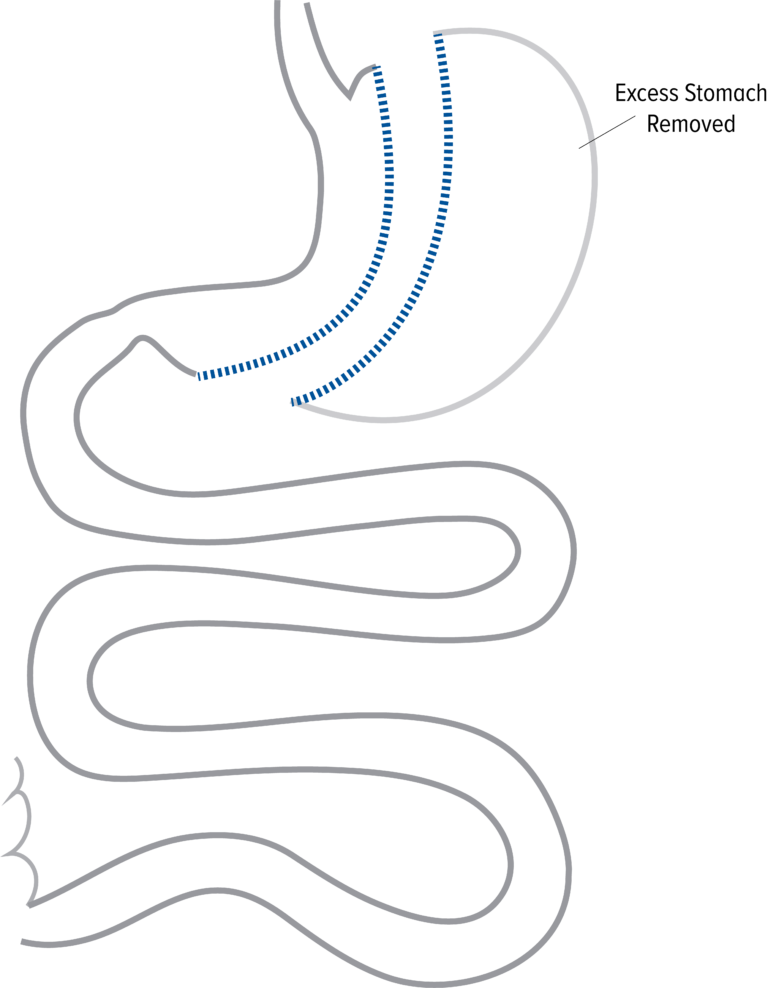Thinking About Bariatric Surgery? Let Us Help
Sign Up for an Information Session
Sign UpGet Started on the Path to Weight Loss
Get StartedSleeve Gastrectomy
Sleeve gastrectomy is a laparoscopic procedure that reduces the size of the stomach. A normal stomach can hold over a liter of contents. Removing most of the stomach reduces the amount of food the stomach can hold. The size of the stomach after surgery is about 20 percent of its original size.
No rerouting of the intestinal tract takes place during a sleeve gastrectomy and no intestine is bypassed. Food passes through the intestinal tract in its normal order. This operation is not adjustable or reversible.
The new smaller stomach holds about a half-cup of food, rather than the roughly six cups that a normal stomach holds. It fills with food quickly, which means you won't be able to eat as much, and will feel full faster, yet it also allows you to absorb nutrients from food normally.
Highlights
- Simplest bariatric procedure
- Included in bariatric benefits by most insurance companies
- Minimal risk of dumping syndrome

What to Expect
The sleeve gastrectomy is typically performed in less than an hour. During the procedure, our surgeons employ laparoscopic techniques, making a small incision and using long-shafted instruments to exam the patient's abdomen. The stomach is freed from its attachments and divided with a stapling device. The stapling device seals the stomach and divides tissue.
The new smaller stomach is shaped like a banana. The valve at the outlet of the stomach is left intact, which allows for the normal process of stomach-emptying and the feeling of fullness. Only the stomach organ is altered, and the intestine also remains intact/unchanged.
Often, most patients feel less hungry and are less interested in carbohydrates, and patients lose weight despite usually not feeling hungry.
Common side effects early on include nausea and feeling full, especially if a patient eats too quickly or too much. An average meal should be one cup of food, or less, over the course of 30 minutes. Meals should be eaten five times daily, spaced roughly three to four hours apart.
Results
The average weight loss from a sleeve gastrectomy depends on several factors, the most important being the compliance of the patient in regards to their diet. Other factors include starting weight, how active the patient is, exercise, avoiding high calorie beverages, and complying with medical therapy for other conditions. Average weight loss is between 50 and 70 percent of excess weight. Results vary by patient.
Disadvantages
- Increased risk of reflux disease
- Weight loss success is more dependent on lifestyle changes
- It can help you feel satisfied sooner and with less food, but it won't eliminate the desire to eat
Potential Concerns
In addition to standard surgical risks, concerns to be aware of include:
- Nausea and vomiting
- Leaks from staple line
- Gastric reflux
- Mortality rate: 0.08 percent
This Surgery May Not Be Right for You
If you have these conditions, this surgery may not be right for you:
- Inflammatory disease or condition of the gastrointestinal tract, such as ulcers, severe esophagitis or Crohn's disease
- A problem that could cause bleeding in the esophagus or stomach, such as esophageal or gastric varices (a dilated vein)
- Portal hypertension, cirrhosis or pancreatitis
- Congenital or acquired abnormality of the esophagus, stomach or intestine
- Prior gastric surgery
- Not healthy enough for a major surgery